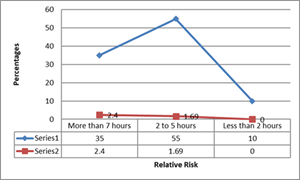Association Between Screen Time and Anxiety Among College Students
Authors
##plugins.themes.bootstrap3.article.main##
Abstract
An increase in screen time can increase the dependence over these devices and influence psychological wellness and result in anxiety. Aim: The aim of present study was to assess an association between screen time and anxiety among college students. Materials and methods: This was a questionnaire based quantitative, cross-sectional and observational study conducted on college students using STROBE guidelines. Total 500 college students studying in both public and private colleges were randomly selected. Students using screen-containing devices & willing to give consent to participate in the study were included. Chi-square test was used along with regression analysis to determine statistical significance and association between screen time spent and anxiety. Results and Observations: Students who were spending more than 7 hours/day on any form of screen had more cases of anxiety when compared with those spending 1 hour/day. Moderate usage was also found to exhibit higher risk of developing anxiety. Students spending less than 2 hours/day of screen time were found to have no risk of anxiety. Conclusion: Present study reported positive association between anxiety and increased screen time among college students.
##plugins.themes.bootstrap3.article.details##
Copyright (c) 2025 Anupsinh H Chhasatia

This work is licensed under a Creative Commons Attribution 4.0 International License.
Creative Commons License All articles published in Annals of Medicine and Medical Sciences are licensed under a Creative Commons Attribution 4.0 International License.
[1] Twenge JM, Martin GN, Campbell WK. Decreases in psychological wellbeing among American adolescents after 2012 and links to screen time during the rise of smartphone technology. Emotion 2018;18:765-80.
[2] Kim HH. The impact of online social networking on adolescent psychological well-being (WB): a population-level analysis of Korean school-aged children. Int J Adolesc Youth 2017; 22:364-76.
[3] Przybylski AK, Weinstein N. A large-scale test of the Goldilocks hypothesis: quantifying the relations between digital-screen use and the mental well-being of adolescents. Psychol Sci 2017;28:204-15.
[4] Chiasson MA, Scheinmann R, Hartel D. Predictors of obesity in a cohort of children enrolled in WIC as infants and retained to 3 years of age. J. Community Health 2016; 41:127-33.
[5] De Jong E, Visscher TLS, HiraSing RA, Heymans MW, Seidell JC, Renders CM. Association between TV viewing, computer use and overweight, determinants and competing activities of screen time in 4- to 13-year-old children. Int J Obes 2013; 37:47-53.
[6] Dumuid D, Olds T, Lewis LK. Health-related quality of life and lifestyle behavior clusters in school-aged children from 12 countries. J Pediatr 2017;183:178-83.
[7] Poitras VJ, Gray CE, Janssen X. Systematic review of the relationships between sedentary behaviour and health indicators in the early years (0-4 years).BMC Public Health 2017;17:868-72.
[8] Babic MJ, Smith JJ, Morgan PJ, Eather N, Plotnikoff RC, Lubans DR. Longitudinal associations between changes in screen-time and mental health outcomes in adolescents. Ment Health Phys Act 2017;12:124-31.
[9] Page AS, Cooper AR, Griew P, Jago RP. Children's screen viewing is related to physiological difficulties irrespective of physical activity. Pediatrics 2010;126:1011-7.
[10] Romer D, Bagdasarov Z, More E. Older versus newer media and the well-being of United States youth: results from a national longitudinal panel. J. Adolesc. Health 2013;52: 613-9.
[11] Granic I, Lobel A, Engels RE. The benefits of playing video games. Am Psychol 2014;69, 66-78.
[12] Odgers C. Smartphones are bad for some teens, not all. Nature 2018;554:432-4.
[13] Przybylski AK, Weinstein N. A large-scale test of the Goldilocks hypothesis: quantifying the relations between digital-screen use and the mental well-being of adolescents. Psychol Sci 2017;28:204-15.
[14] Graham EK, Rutsohn JP, Turiano NA. Personality predicts mortality risk: an integrative data analysis of 15 international longitudinal studies. J. Res Pers 2017;70:174-86.
[15] Shipley BA, Weiss A, Der G, Taylor MD, Deary IJ. Neuroticism, extraversion and mortality in the UK Health and Lifestyle Survey: a 21-year prospective cohort study. Psychosom Med 2007;69:923-31.
[16] Shor E, Roelfs DJ, Yogev T. The strength of family ties: a meta-analysis and meta-regression of self-reported social support and mortality. Soc Networks 2013; 35:626-38.
[17] Hawton K, Casanas I, Conabella C, Haw C, Saunders K. Risk factors for suicide in individuals with depression: a systematic review. J Affect Disord 2013;147:17-28.
[18] Teychenne M, Hinkley T. Associations between Screen-Based Sedentary behaviour and Anxiety Symptoms in Mothers with Young Children. PLoS One 2016;11(5): e0155696-100.
[19] Satici SA, Uysal R. Well-being and problematic Facebook use. Comput. Hum Behav 2015;49:185-90.
[20] Hinkley T, Verbestel V, Ahrens W. Early childhood electronic media use as a predictor of poorer well-being: a prospective cohort study. JAMA Pediatr 2014; 168: 485-92.
[21] Kim HH. The impact of online social networking on adolescent psychological well-being (WB): a population-level analysis of Korean school-aged children. Int J Adolesc Youth 2017; 22:364-76.
[22] Kross E, Verduyn P, Demiralp E. Facebook use predicts declines in subjective well-being in young adults. PLoS One 2013;8:e69841-9.
[23] Schmiedeberg C, Schröder J. Leisure activities and life satisfaction: an analysis with German panel data. Appl Res Qual Life 2017;12:137-51.
[24] Dwyer R, Kushlev K, Dunn E. Smartphone use undermines enjoyment of face-to face social interactions. J Exp Soc Psychol 2018;78:233-9.
[25] Tromholt M. The Facebook experiment: quitting Facebook leads to higher levels of well-being. Cyberpsychol Behav Soc Netw 2016;19:661-6.
[26] Gunnell KE, Flament MF, Buchholz A. Examining the bidirectional relationship between physical activity, screen time, and symptoms of anxiety and depression over time during adolescence. Prev Med 2016; 88:147-52.
[27] Suchert V, Hanewinkel R, Isensee B. Sedentary behavior and indicators of mental health in school-aged children and adolescents: a systematic review. Prev Med 2015;76:48-57.
[28] Domingues-Montanari S. Clinical and psychological effects of excessive screen time on children. J Paediatr Child Health. 2017;53:333-8.
[29] Francisquini MCJ, Silva TMS, Santos GC, Barbosa RO, Dias PHG, Ruiz AB et al. Associations of screen time with symptoms of stress, anxiety and depression in adolescents. Rev Paul Pediatr 2025;43:e2023250-6.
[30] Saat M, Hanawi SA, Hanafiah H, Ahmad M, Farah NMF, Abdul Rahman NAA. Relationship of screen time with anxiety, depression, and sleep quality among adolescents: a cross-sectional study. Front Public Health 2024;12:1459952-8.

